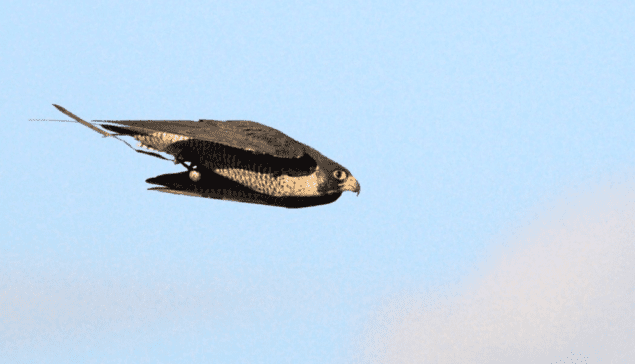
Peregrine falcons dive from great heights and at extreme speeds when hunting to generate high aerodynamic forces that enable them to execute precise manoeuvres and catch agile prey. Using a physics-based computer simulation, researchers in the Netherlands and the UK have explained why the raptors have evolved an attack strategy that puts extreme physical and cognitive demands on them. The research could also help with the development of autonomous flapping-wing drones.
The peregrine falcon is the fastest diving bird in the world and the fastest animal on the planet. According to Guinness World Records, in 2005 one was recorded travelling at speeds of more than 380 km/h while stooping – diving after prey.
Dropping out of the sky
“Witnessing the high-speed stoop of a peregrine falcon is impressive: a falcon may first soar at altitudes of several hundred metres, up to several kilometres above their prey,” says Robin Mills, a biologist at the University of Groningen, in the Netherlands, and academic visitor at the University of Oxford. “Then, within the blink of an eye, it dives down – first flapping forcefully and then folding its wings to decrease drag. It basically appears to drop out of the sky. When the falcon nears its prey, it may knock it with a massive blow, or catch it with its talons.”
Mills’ colleagues at the University of Oxford previously demonstrated – using onboard GPS loggers and cameras – that stooping peregrine falcons use the same steering laws as many man-made, guided missiles. Using these “proportional navigation” rules, the falcons remain on a collision course with their prey by simply tracking changes in their line-of-sight on the target. If the angle of the line-of-sight changes the falcon turns at a rate proportional to the speed of that change. With a constant of proportionality, known as the navigation constant, determining the falcon’s turn rate and how quickly it hits its target.
Simulated attacks
In the latest research, described in PLOS Computational Biology, the team built a physics-based simulation of falcon attacks on aerial prey to investigate why they stoop from great heights and at extreme speed.
The simulation modelled the aerodynamic forces on falcons during stoops, and how they target and react to prey using proportional navigation. It was run millions of times, with the researchers varying the falcon’s starting position, its navigation constant, and assumptions about errors and delays in its vision and control. They also modelled different patterns of prey flight.
Previously it had been suggested that falcons’ high-speed dives surprise prey, which then struggle to respond in time. But it had also been presumed that the speed of the attack would reduce precision, particularly if the prey turned sharply.
The researchers discovered, however, that when prey moves erratically the extreme speed of a falcon’s stoop maximizes aerodynamic forces that enable precise manoeuvring and increase catch success compared to slower, low-altitude attacks.
Intercepting prey
“By folding the wings appropriately, the stooping falcon is able to reach the lateral acceleration (of over 15 g), and roll acceleration – agility – required to meet its steering demands and by using the same mathematical steering rules as man-made missiles, the falcon is able to intercept sharply turning prey without turning sharply itself,” explains Mills.
According to the simulation, this only works if the falcon’s guidance law is precisely tuned, and if the birds have a high degree of steering control and visual precision. The researchers say that this shows that the stoop is a highly specialized attack strategy, adding that the optimal navigation constant for the simulation was close to that observed in peregrine falcons.
The team also found that high-speed stoops do not require faster reaction times than slower attacks. “By increasing the falcon’s agility, the stoop compensates for the decrease in catch success otherwise resulting from a slow response,” explains Mills. “If the falcon’s decision making was essentially instantaneous, it wouldn’t require a high-speed stoop to catch most prey.”
Replacing falcons
Ultimately, Mills hopes to use the data to develop fully autonomous flapping-wing drones. One practical application of such technology would be to replace the costly falconers and falcons currently used at airports to chase away birds, to prevent them flying into plane engines.
“What is great about our simulations is that it bridges the gap between artificial flying machines and biology: by uniquely combining theoretically derived optimal control laws with empirically verified aerodynamic modelling, attack behaviour and physiological constraints of real birds, we learn precisely learn what birds are doing and why – but also how to better control man-made flapping-wing drones,” Mills says.



